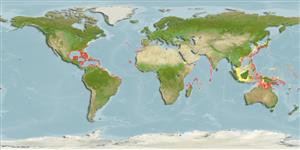Actinopterygii (ray-finned fishes) >
Tetraodontiformes (Puffers and filefishes) >
Balistidae (Triggerfishes)
Etymology: Canthidermis: Greek, kanthos = the outer or inner corner of the eye, where the lids meet, 1646 + Greek, derma = skin (Ref. 45335).
Environment / Climate / Range
Ecology
Marine; reef-associated; depth range 5 - 60 m (Ref. 36453), usually 5 - 30 m (Ref. 40849). Tropical, preferred ?; 43°N - 17°S
Western Atlantic: Canada (Ref. 5951) to Massachusetts (USA), Bermuda, and northern Gulf of Mexico to South America. Eastern Atlantic: St. Paul's Rocks, Ascension, Cape Verde and St. Helena (Ref. 5288); Sao Tome Island (Ref. 34088).
Size / Weight / Age
Maturity: Lm ? range ? - ? cm
Max length : 65.0 cm TL male/unsexed; (Ref. 9710); max. published weight: 6.1 kg (Ref. 40637)
Dorsal
spines
(total): 3;
Dorsal
soft rays
(total): 25-28;
Anal
spines: 0;
Anal
soft rays: 23 - 25. Soft dorsal and anal fins very elevated anteriorly, the longest rays nearly as long as head; caudal fin double-emarginate, brownish gray with a large dark brown spot at base of pectoral fins (Ref. 13442).
Common near drop-offs of seaward reefs (Ref. 9710). Occasionally in shallow water. Solitary or in small groups in open water. Often associated with Sargassum (Ref. 9710). Feeds mainly on large zooplankton. Minimum depth reported from Ref. 13121.
Life cycle and mating behavior
Maturity | Reproduction | Spawning | Eggs | Fecundity | Larvae
Robins, C.R. and G.C. Ray, 1986. A field guide to Atlantic coast fishes of North America. Houghton Mifflin Company, Boston, U.S.A. 354 p. (Ref. 7251)
IUCN Red List Status (Ref. 115185)
CITES (Ref. 94142)
Not Evaluated
Threat to humans
Harmless
Human uses
Fisheries: commercial; gamefish: yes; aquarium: commercial
More information
ReferencesAquacultureAquaculture profileStrainsGeneticsAllele frequenciesHeritabilityDiseasesProcessingMass conversion
Tools
Special reports
Download XML
Internet sources
